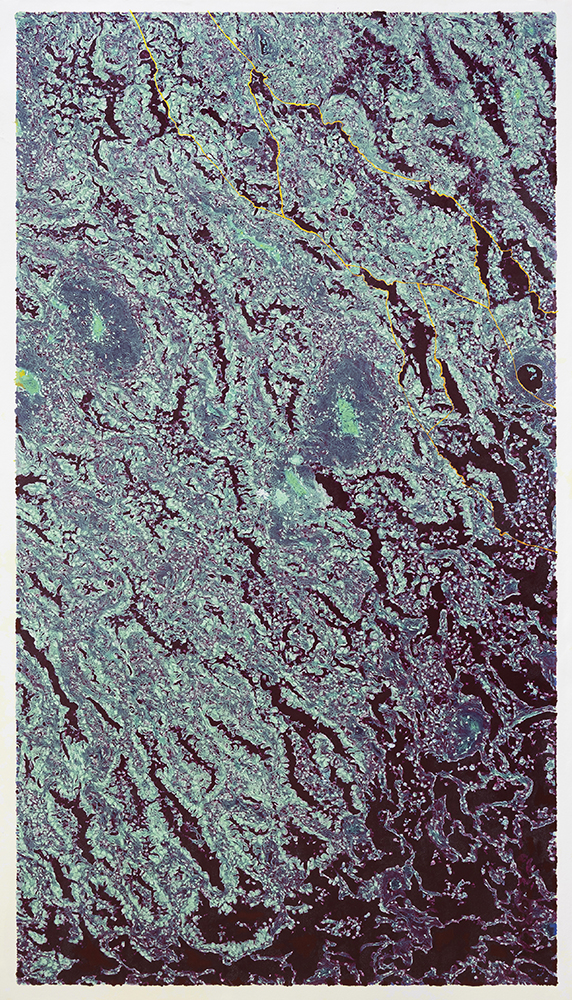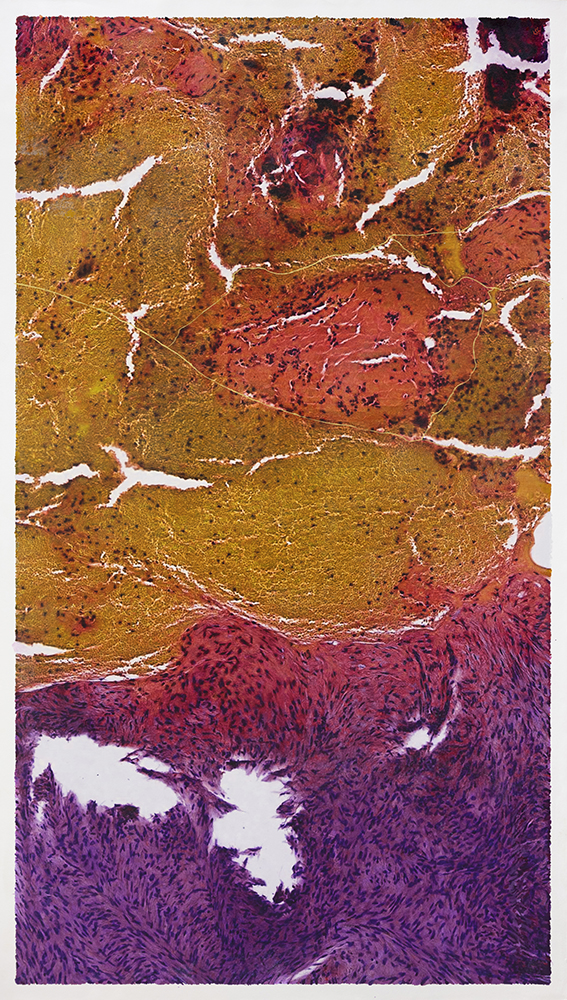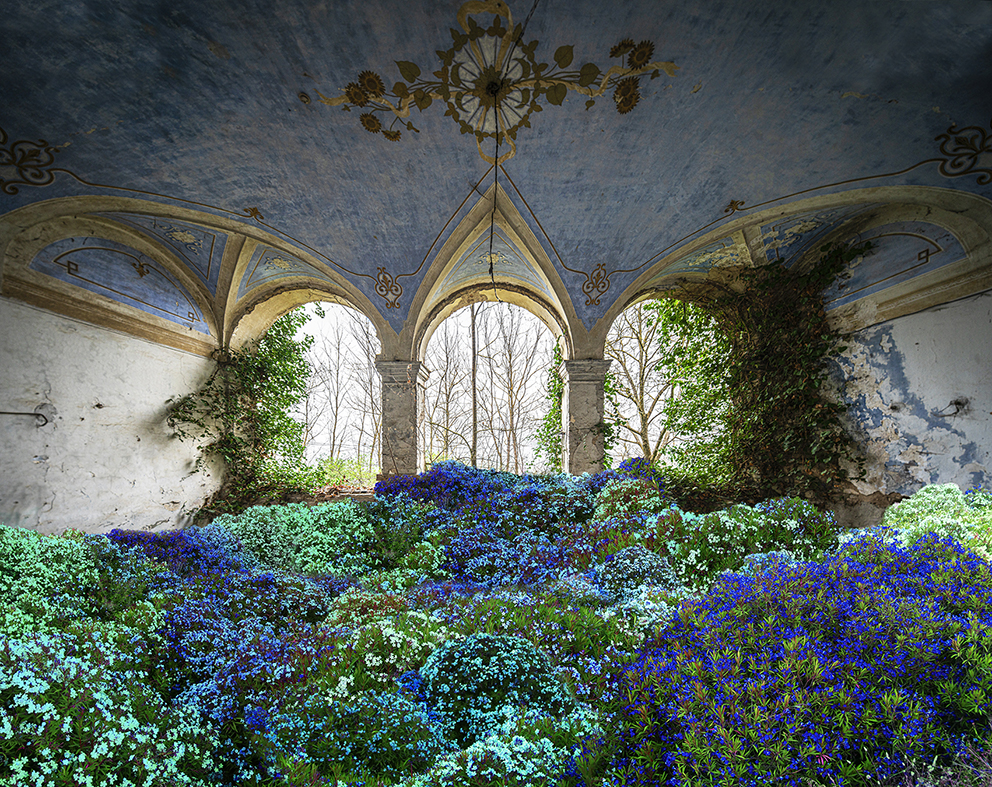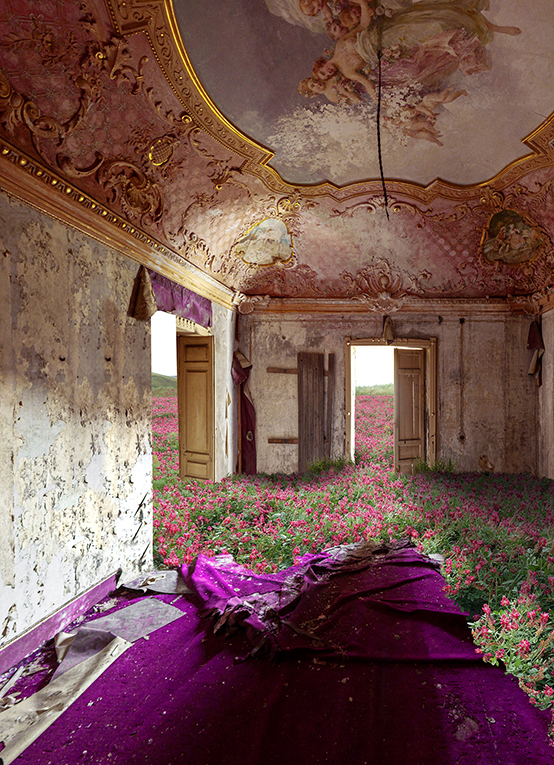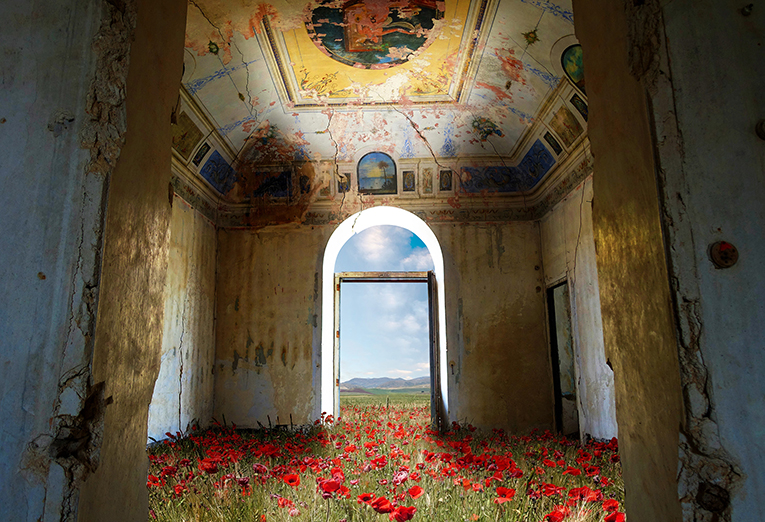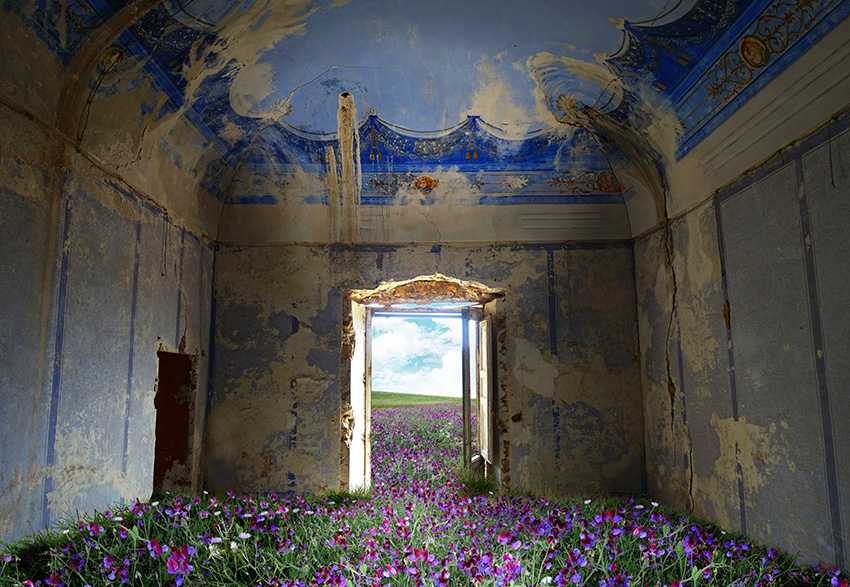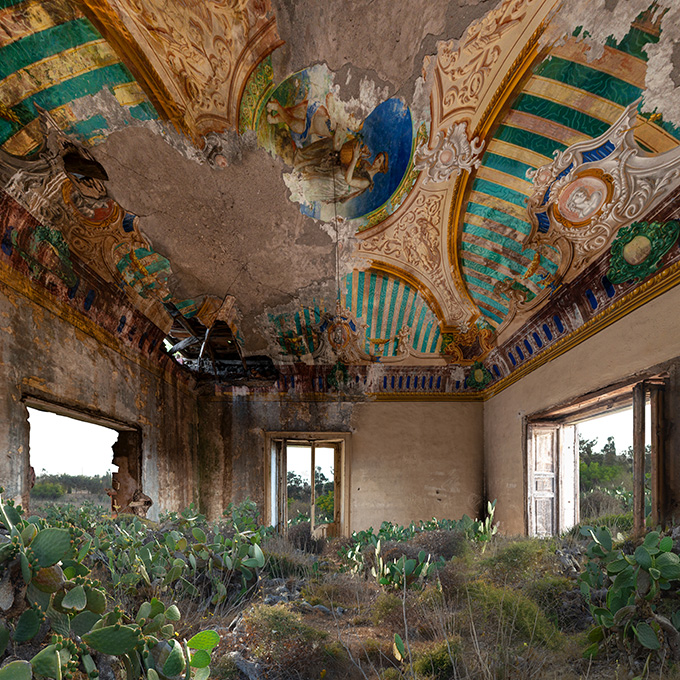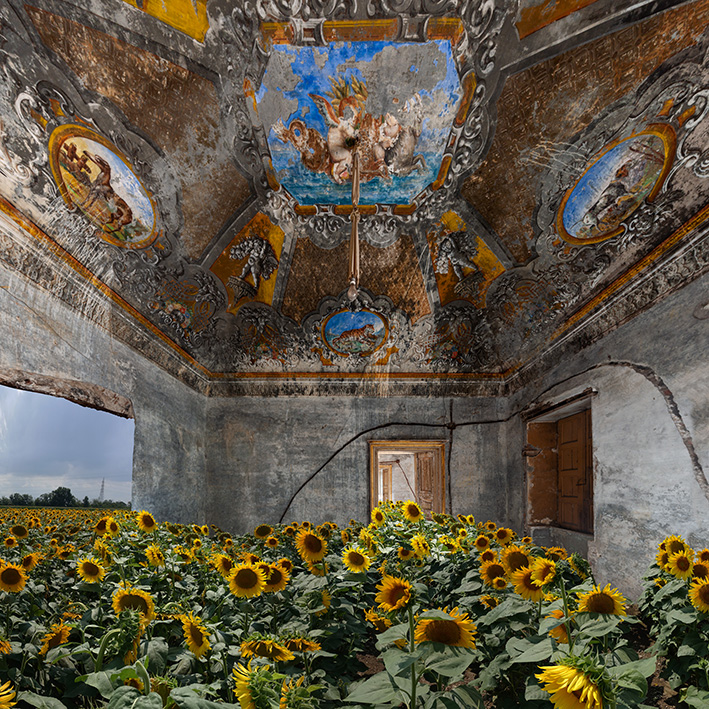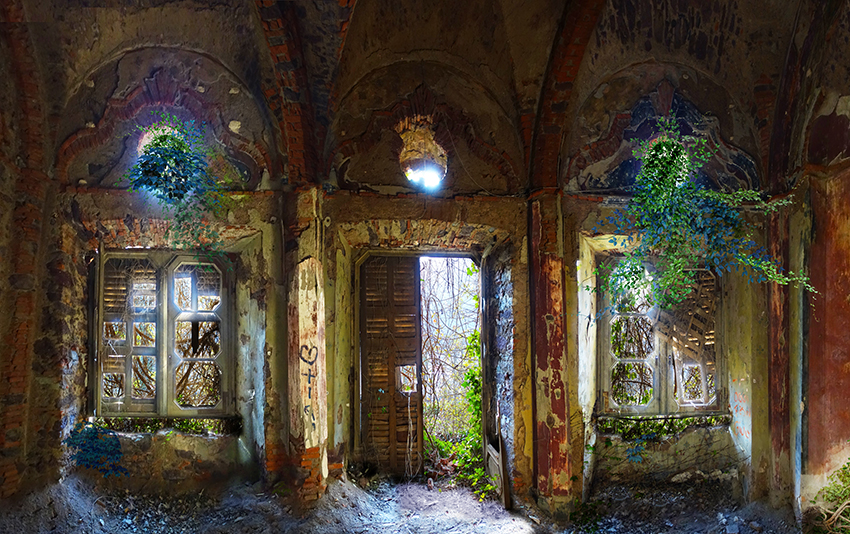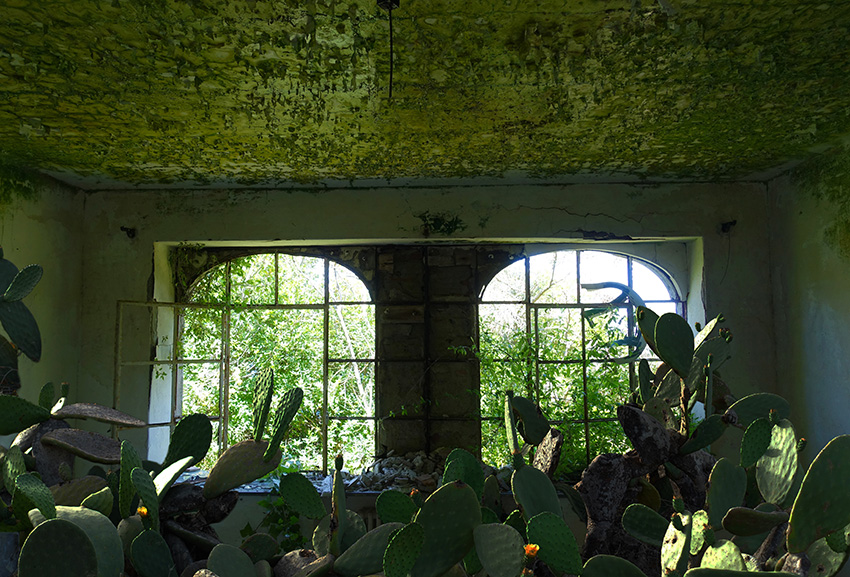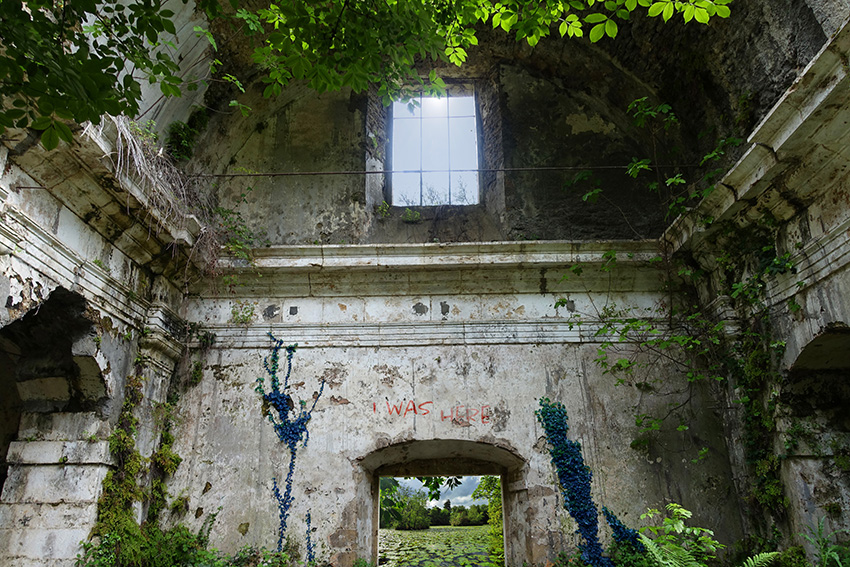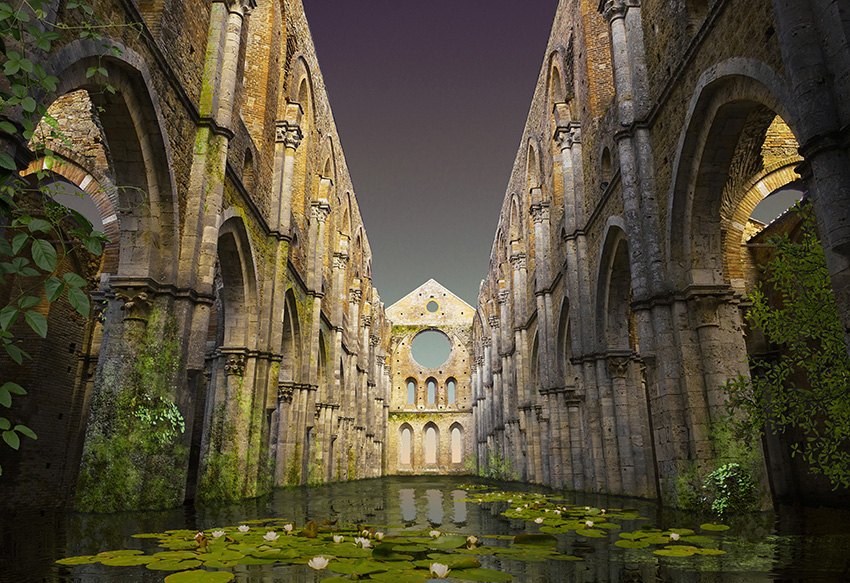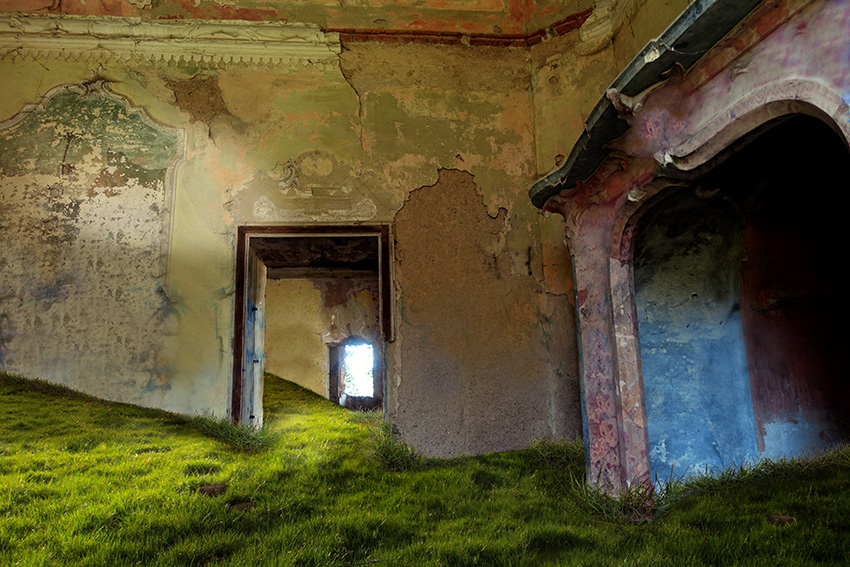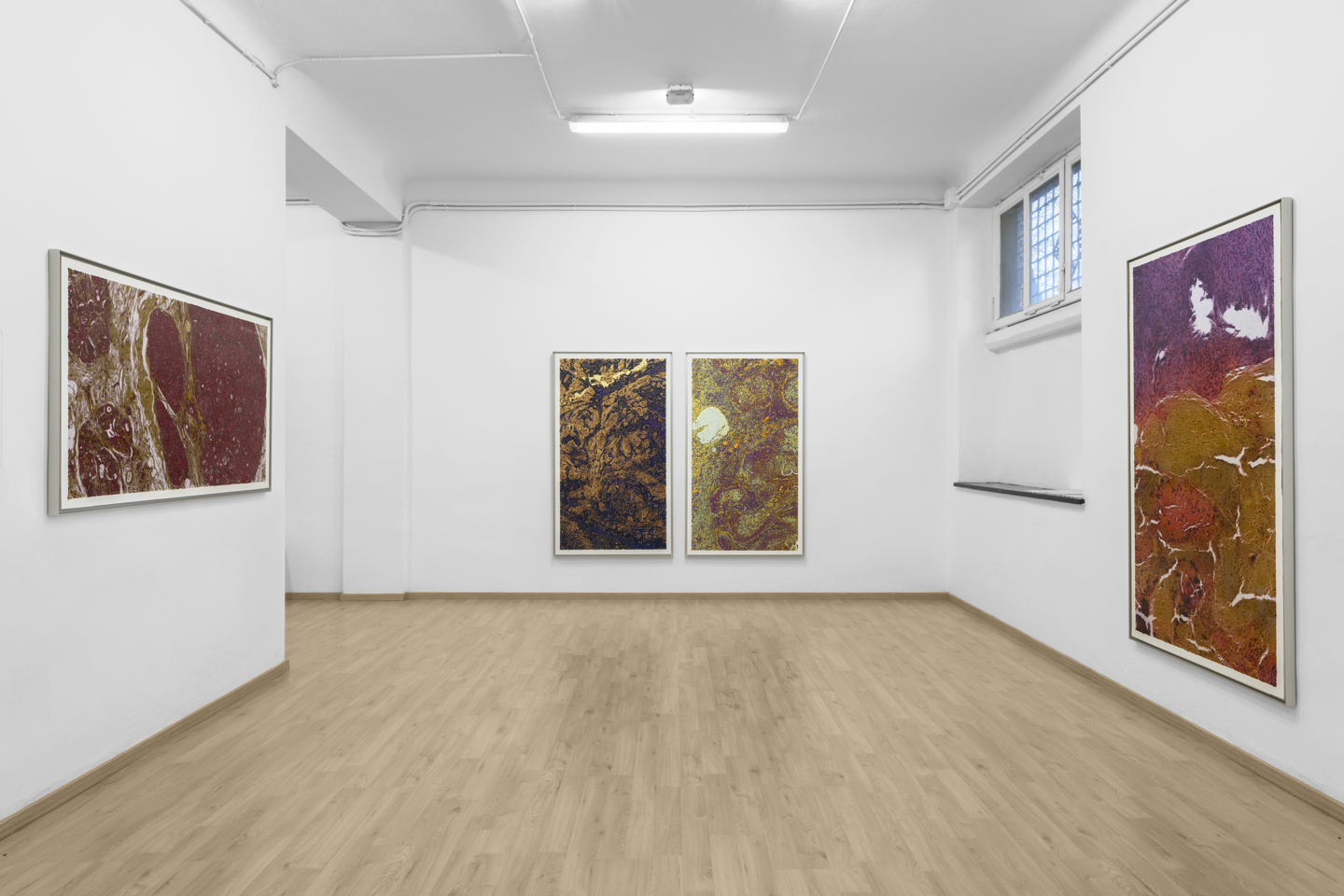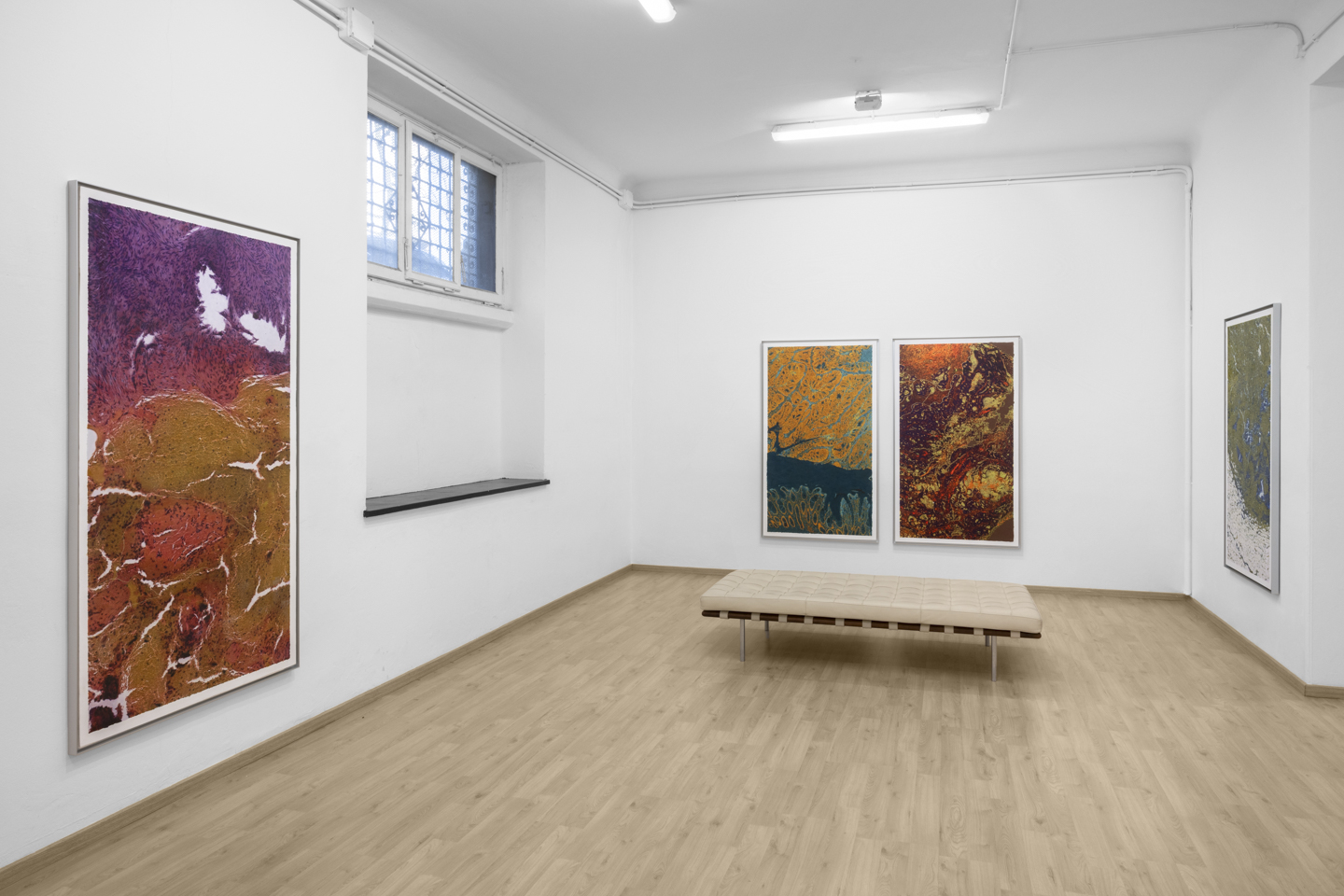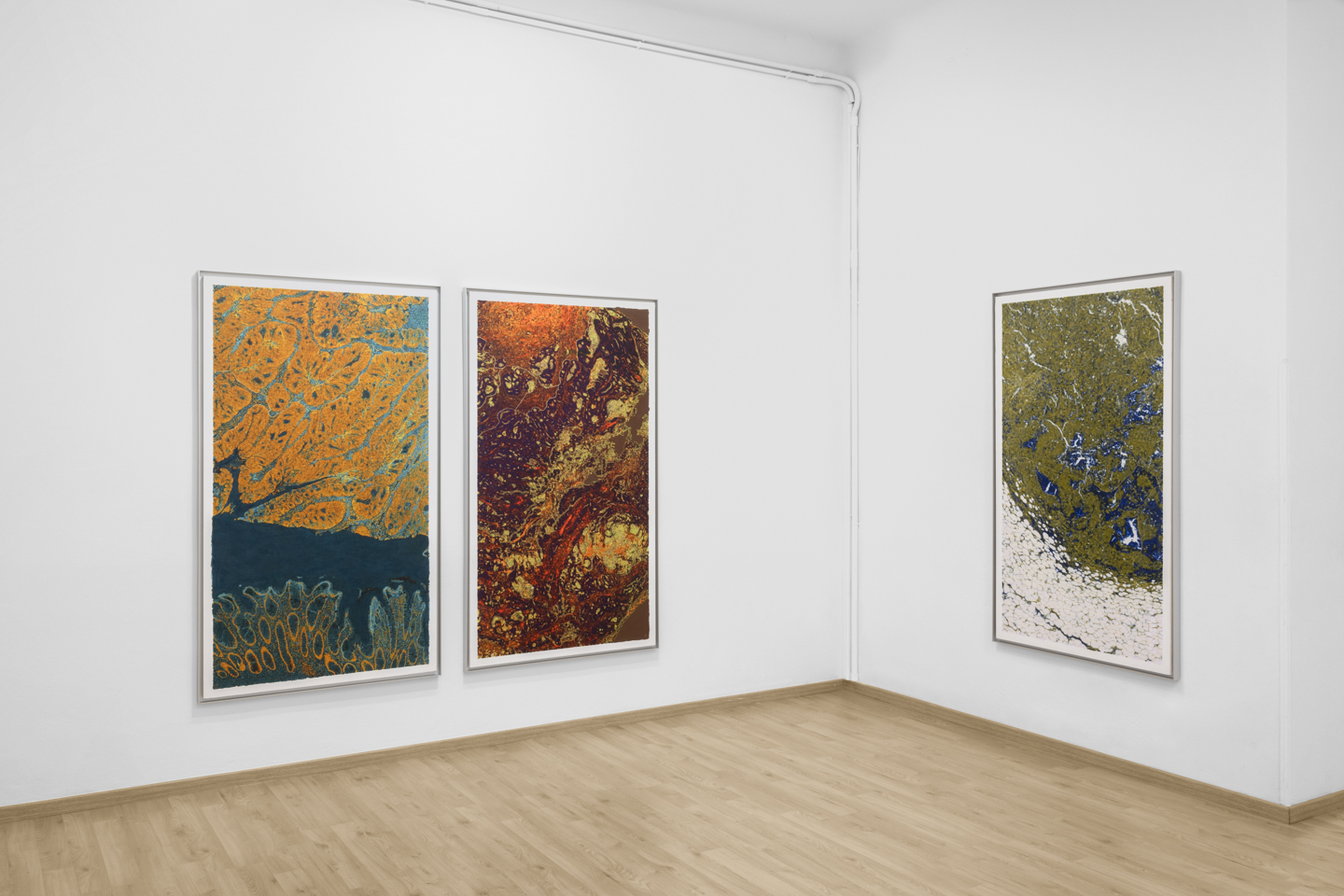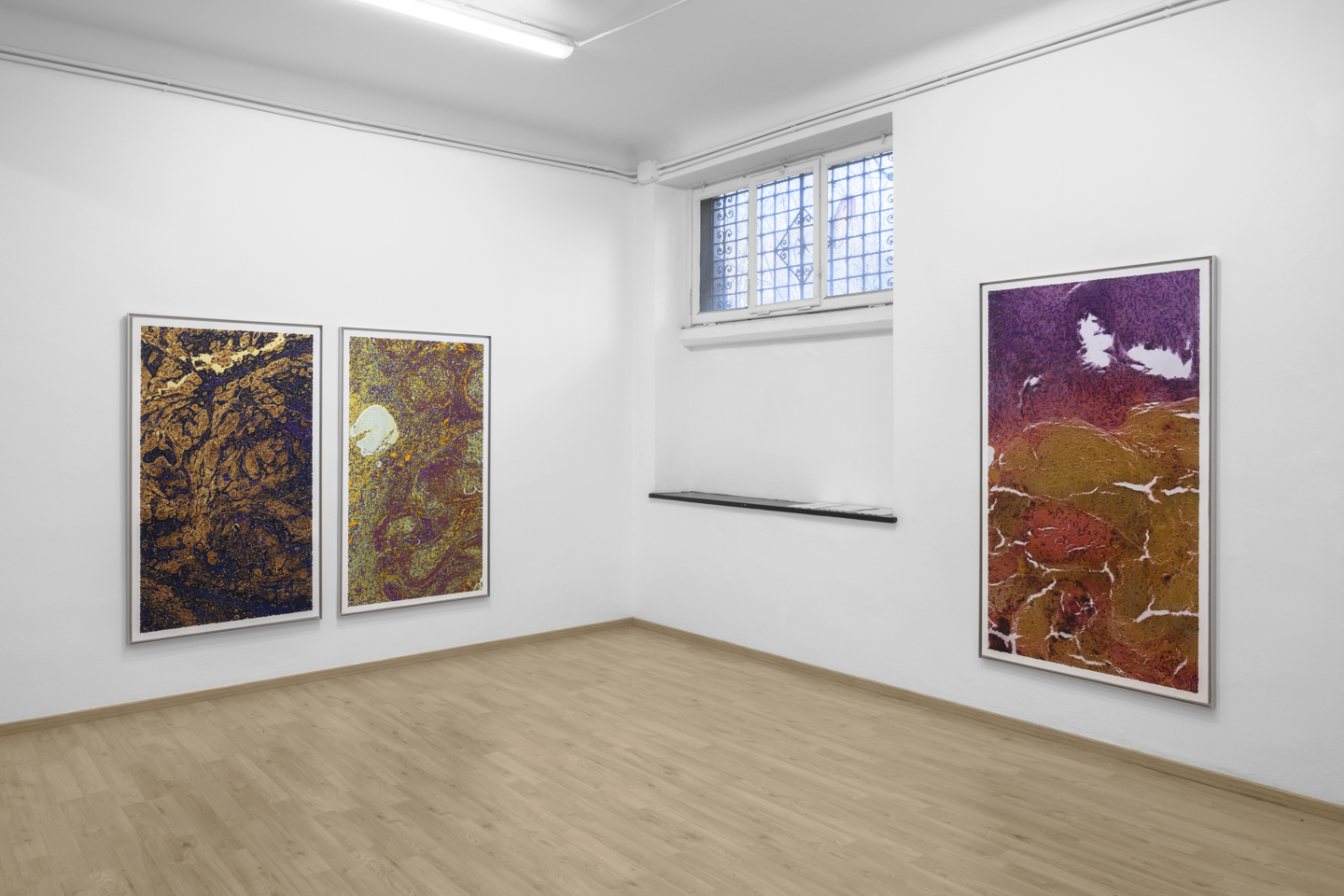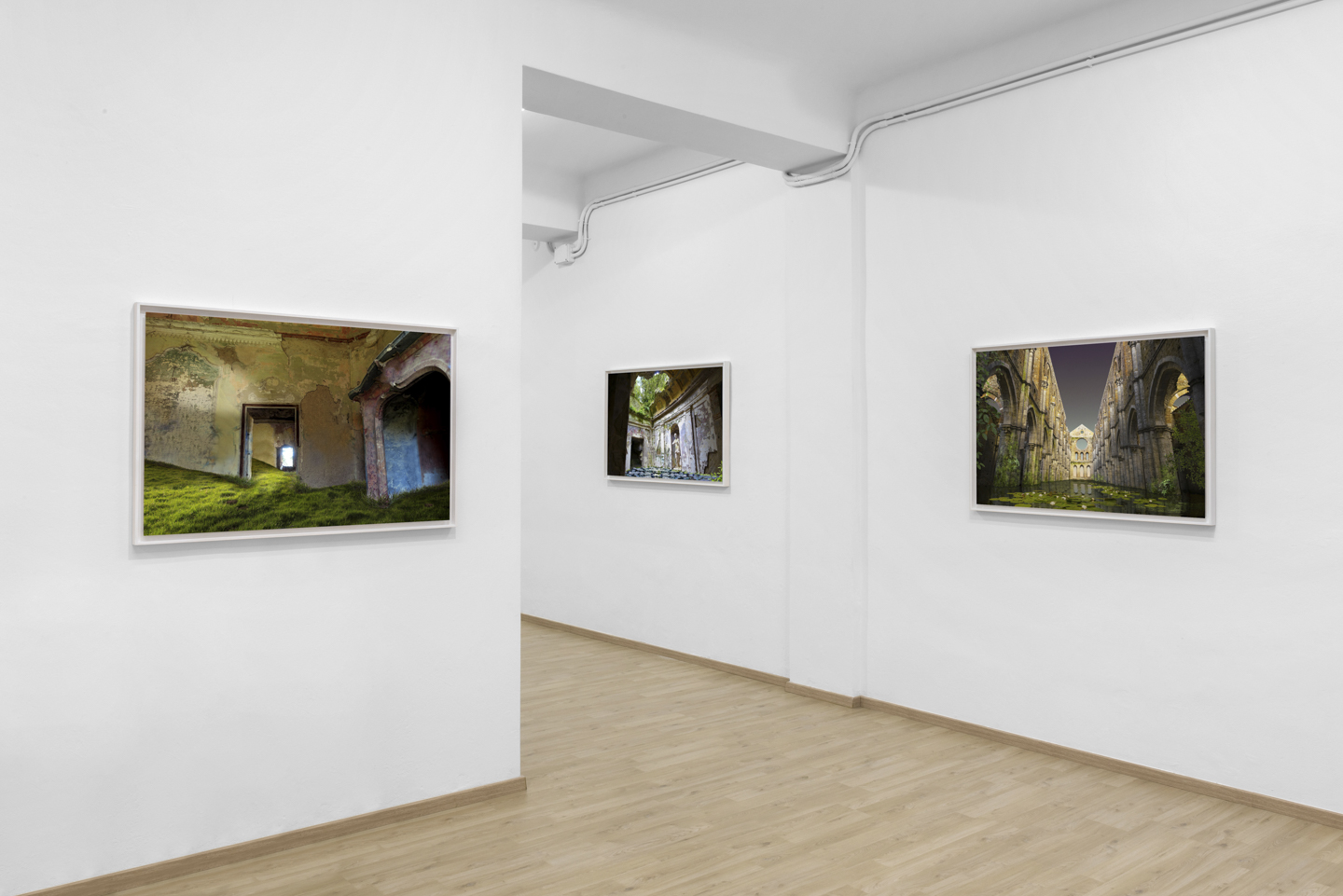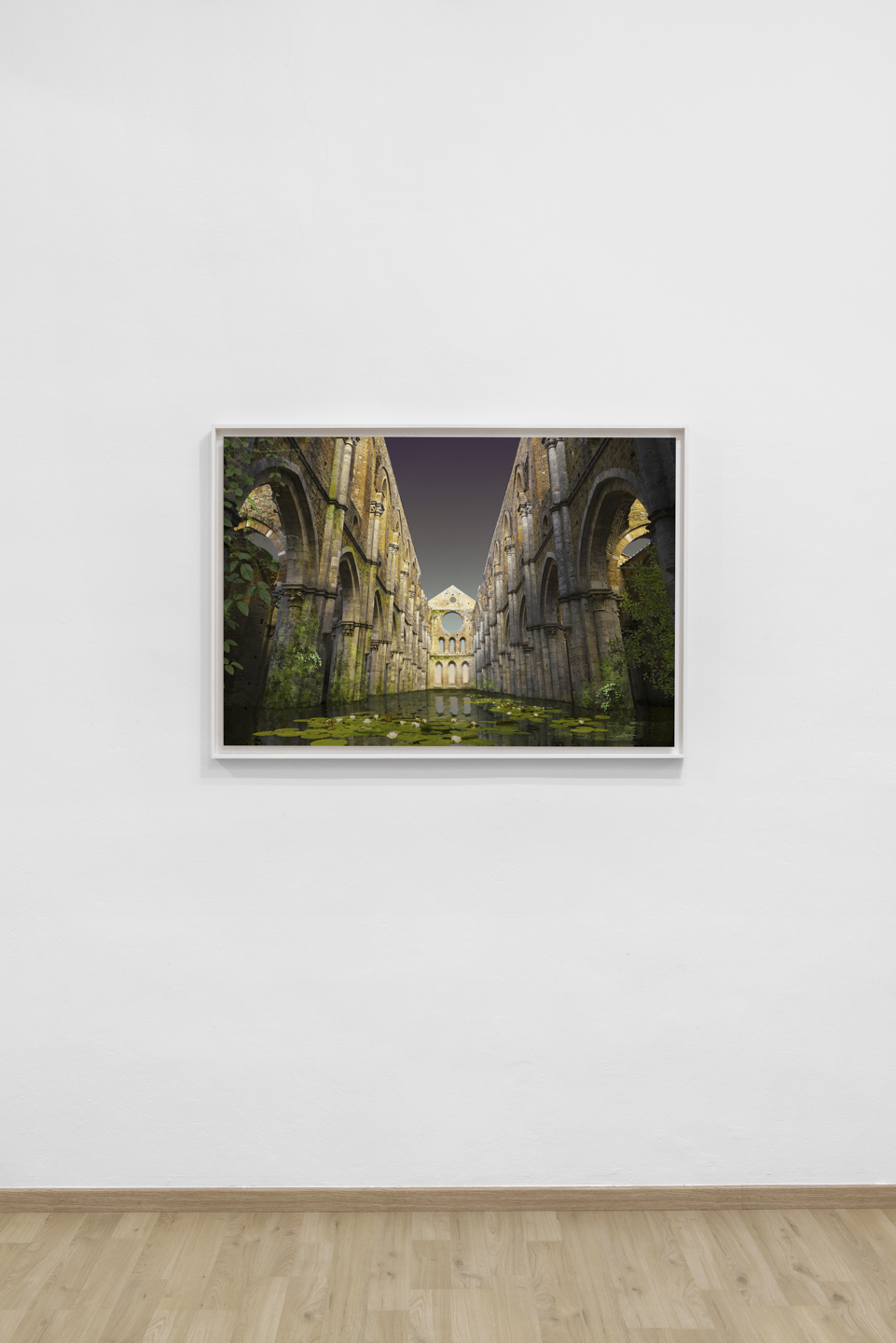” Corpi in attesa (Bodies on hold)“
Aldo Salucci wants to draw attention to the diversity of every human being, with his fragilities and probable wounds. The artist urges us to look to the future with hope and to stigmatize every torment. Every human being finds himself faced with difficulties during his existence but the important thing is not to be overwhelmed. An invitation to accept all traumas and to conceive them as strengths and characterizing elements.
The works, which at first glance resemble satellite photos of terrestrial landscapes, instead represent human cells seen under a microscope. In the works we find “wounds” that the artist sews up by intervening with gold dust, inspired by the Japanese technique of kintsugi or kintsukuroi (“repairing with gold”). This practice in fact arises from the idea that imperfection and wounds can give rise to a greater form of aesthetic and interior perfection.
“And it is precisely by collecting all those fragments of evidence from our past, between tests passed and others failed, in an attempt to harmoniously put them back together, we can understand that only when we dislocate ourselves can we discover exactly how and what we are really made of”.
” On the Nature of Things “
The works in the cycle entitled “On the Nature of Things”, masterfully imagine an autonomous, future scenario. A possible future that, as such, may already be appropriate in the present of isolated, forgotten places where man’s presence is alluded to but in the past, where nature has re-appropriated its spaces, thus confirming its indisputable key position in the totality of reality. The dialectics emerging from these possible scenarios is anything but taken for granted and the Salucci’s spectacular images are wavering. What seems to be at the centre of the question is nature’s claim as creator even and of human action. Following its times and needs, it takes, removes and reclaims what has always belonged to it.The result is an aesthetically harmonious and contradictory union, created from the complicity of vivid natural elements that insinuate their way into the nooks and crannies of ancient, half-forgotten places with the aim of originating a feeling in the balance between inherency and disorientation, reassurance and perturbance, nostalgia and fulfilment that, in turn, suggest in unison a questioning of pre- established manmade scenarios.
Biography
"Corpi in attesa" | 7.3- 31.5.2024
Aldo Salucci – Corpi in attesa (Bodies on hold)
PRESS RELEASE
A.MORE Gallery is pleased to present the solo exhibition “Corpi in attesa (Bodies on hold)” of Aldo Salucci, curated by Domenico de Chirico.
CRITIC TEST
«Sacred things should only be taught to pure people; it is a sacrilege to communicate them to the profanes before having introduced them into the mysteries of science.”
(Prolegomeni-Ippocrate, cit. in René Lachaud, op. cit., pag. 70.)
Having human biology and anatomy as their starting point, the daring works of the new cycle of photographs by the Roman artist, Milanese by adoption, Aldo Salucci, entitled “Corpi in attesa – (Bodies on hold)”, present themselves as strongly epistemological. The works set the objective of dissecting an infinite and articulated universe made up of both references and senses, whose veins are composed, in turn, of a tangle of expectations and hopes, of traumas and pains, of lively interpersonal relationships in contrast with states of profound loneliness and suffering.
This new impulse viscerally shatters the dialectic carried out by Salucci in which, once again, the vivid, alienating and intense colors place the accent on the omnipresent and overflowing impulse of nature which often rages in all its trembling imponderability. What follows is the attempt to develop an authentic art, what the Greeks called téchnē, here to be understood in the sense of “expertise”, which generates a series of images that come to our eyes presenting themselves as highly dogmatic yet indistinguishable. This is a rather substantial cycle of photographs, taken using an electronic microscope, that talks about lacerating neoplasms, in whose methodology, in order to highlight the diseased part, the one tormented by tumor cells, he uses materials and particularly colorful chemical reagents. Indulging a very personal holistic vision, Salucci, in doing so, does not intend to aesthetically enhance something that is clearly a source of prostrating pain but rather to portray it exactly as it is and more closely, in a perpetual motion that analyzes it inside and out, in the full and in the voids, crossing it in all its physical and transcendental physiognomy. All these wounds and lacerations, uncontrollable, sudden and deep, sometimes irreversible, are lovingly stitched up by hand by Aldo Salucci, who intervenes by painting on the photograph itself using the so-called Japanese technique of kintsugi or kintsukuroi, literally “repairing with gold”, considering that assumption according to which the action of embellishing what is broken with gold dust often accentuates beauty, making every fragility a point of impeccable strength. This constitutes an imperative exhortation to first accept all our traumas and then conceive them as strengths, considering them as further characterizing elements of our being unique in the world. And it is precisely by collecting all those fragments of evidence from our past, between tests passed and others failed, in an attempt to harmoniously put them back together, we can understand that only when we dislocate ourselves we can discover exactly how and what we are really made of.
And, therefore, referring to the motto of Positivism, the one created by the French philosopher Auguste Comte in 1852, that is: “love as a principle, order as a foundation, progress as an end” and setting itself the objective of stigmatizing every source of deep pain, Salucci, through this new series of works, courageously resorts to facts, to experimentation, to the test of reality, moving away from speculative discourses and the search for the absolute, accepting the innate limits of reason and, therefore, of the relativity of knowledge , relying on man’s ability to control the facts, in an attempt to direct them towards new and increasingly surprising horizons, albeit, in this case, imbued with a teeming and extremely painful inexorability. Salucci suggests that we penetrate pain and read it in all its dehumanizing authority, considering it as, in the words of the great and tormented poet Alda Merini, a «clear lack of horizons», «without tomorrow» which categorically “closes his lips”, who, bursting furiously, bestows breath-taking scares with pusillanimous arrogance. Furthermore, we must learn to call things by their name so as not to fuel the fear of the thing itself. On the basis of these assumptions, through a simple, lively, immediate and billowy style, in which the brilliant chromatic nuances rage freely, Aldo Salucci reminds us of the unpostponable importance of rebirth, subsequent only to acceptance, thus giving life to a new era of humanity, what he himself calls the “golden era”, symptomatic of a profound and prosperous re-flowering that tirelessly self-regenerates, sprouting from its darkest but always fruitful ashes. And it is only in this way that the spirit, very high and inviolable, can continue to shine imperturbably, enveloped in its irreplaceable and very luminous golden tones. And as Gabriele D’Annunzio said in his novel “L’Innocente”: «No, no. Breathe. As long as there is breath, there is hope. Courage! And he introduced a teaspoon of ether between the livid lips of the dying man.”
Alda Merini | “Yesterday I suffered pain” from “Sacred Land”, 1984
Yesterday I suffered pain,
I did not know it had a bloodied face,
hard lips of metal,
a total lack of hotizons
Pain has no tomorrow
it is a horse’s muzzle that blocks
the powerful hocks,
but yesterday I fell down low,
my lips closed
and fright filled my chest
with a deep whistle
and the fountains ceased to flower,
their tender water
wad only a sea of pain
in wich I was shipwrecked sleeping,
but even then, I was afraid of the eternal angels.
But if they are so sweet and constant
why does immobility terrify me?
"On the Nature of Things" | 29.9 - 20.12.2021
Aldo Salucci – On the Nature of Things
PRESS RELEASE
A.MORE Gallery is pleased to present the solo exhibition “On the Nature of Things” of Aldo Salucci, curated by Domenico de Chirico.
The works in the new cycle of photos entitled “On the Nature of Things” by Aldo Salucci, Roman by birth but Milanese by adoption, masterfully imagine an autonomous, future scenario. A possible future that, as such, may already be appropriate in the present of isolated, forgotten places where man’s presence is alluded to but in the past, where nature has re-appropriated its spaces, thus confirming its indisputable key position in the totality of reality. The dialectics emerging from these possible scenarios is anything but taken for granted and the Salucci’s spectacular images are wavering. What seems to be at the centre of the question is nature’s claim as creator even and of human action. Following its times and needs, it takes, removes and reclaims what has always belonged to it.
The result is an aesthetically harmonious and contradictory union, created from the complicity of vivid natural elements that insinuate their way into the nooks and crannies of ancient, half-forgotten places with the aim of originating a feeling in the balance between inherency and disorientation, reassurance and perturbance, nostalgia and fulfilment that, in turn, suggest in unison a questioning of pre- established manmade scenarios.
“On the Nature of Things”, a poem by Lucretius which has given the title to this new photographic series and otherwise known as “De rerum natura”, expounds the Epicurean theories on the reality of nature incontrovertibly supported by a “natural order” of things in a universe with an atomistic, materialistic, and mechanistic flavour. This assumption profoundly shakes the dialectic that Salucci carries forward in which alienated, visceral colours place the accent on the omnipresent and archaic impulse of nature to get the better of what it has always supported. Dialectics also impregnates time as the manmade chronological aspect is neutralised, nature responds to its internal logics and, in so doing incorporates, in an almost theatrical way that recalls the bright ancestral colours of ancient tragedies, what it was as what it was can’t be exempted from respecting the same laws and therefore adapting to them. Ataraxy, the last stage in man’s growth process promoted by Lucretius, rhymes with a completely contemporary wisdom, a reference to personal responsibility, an exhortation to mankind to understand current reality and acquire deep consciousness of our inescapable and intrinsic belonging to this world.

